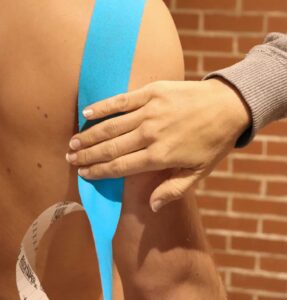
By Anthony Egizi, PT, Clinic Manager
ApexNetwork Physical Therapy – Webster Groves, MO Clinic
Have you ever wondered why those Olympic athletes are wearing bright colored or weird shapes of tape on their shoulder or leg? Believe it or not, it’s not a fashion statement. They are using a form of athletic taping know as Kinesio Tape. This method of taping has been around since 1979 and was created by Dr. Kenzo Kase. Research for Kinesio Taping has been ongoing for over 40 years and has provided substantial results to support the effectiveness of this style of taping in the clinical setting. The first public exposure to Kinesio Tape occurred during the 1988 Seoul Summer Olympics when athletes began using the tape on a world stage while competing. Since then, more and more athletes have been wearing tape in all sports, amateur or professional. More importantly, Kinesio Tape has also grown in use for the non-athlete.
Kinesio Tape is a great facilitator for fascial restriction, dermal and epidermal restriction, muscle restriction, posture, joint stability, and circulatory and lymphatic dysfunction. Taping has many benefits including helping decrease fascial restrictions allowing the fascial tissue to move with the rest of the body; decreasing muscle tension, for example, in lower lumbar paraspinal muscles; and providing shoulder or ankle stability after an injury to a joint, tendon or ligament. Underactive muscles can also be treated with tape to help activate the muscle needed to provide stability or improve posture. In patients who have experienced a surgical procedure, they may also quickly benefit from Kinesio Tape by stimulating the lymphatic system to facilitate swelling reduction postoperatively. In cases of increased sensitivity to the skin, the tape can also reduce the pain that sensitive skin can create, in-turn helping people manage their complex regional pain syndrome.
Now, what exactly allows this tape to treat this wide variety of impairments? The tension and direction of the tape allow for its versatility in not only the body part it can be used but also the diagnosis. No tension to little tension through the tape can help reduce swelling postoperatively or aid in helping decrease pain. Whereas, high tension through the tape can help support and bring stability to an ankle that has been sprained multiple times. You can perform a home exercise plan with tape on without any issues. In fact, the Kinesio Tape will more than likely help aid your ability to do your exercises and maximize your Physical Therapy experience. You can bathe normally with the tape on and it will begin to come off naturally after a couple of days, usually, without any problems. There is no set number of times you can use the tape as long you are seeing and feeling the benefit of having it applied.
All these different taping approaches help to facilitate improved and quicker healing time for the patient. Quicker healing time allows the Physical Therapist to focus on strengthening, mobility, balance, range-of-motion (ROM), and other aspects of the plan of care needed to improve function and quality of life.
Over the past 40 years, the Kinesio Taping method has evolved and is able to help people in the medical world to facilitate quicker healing for their patients. Considering all these uses of the Kinesio Tape it has become a very versatile treatment option for many Physical Therapists. It is important to have a qualified Physical Therapist make a proper assessment to determine how Kinesio Tape might help to manage impairments and achieve improved function. If you are interested in the possible benefits that Kinesio Tape can bring to you, call your local ApexNetwork Physical Therapy office and schedule a Free Injury Screen to receive more information.
